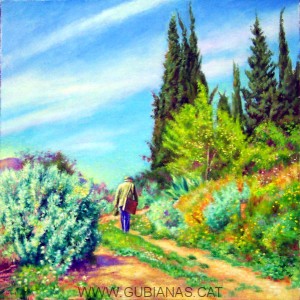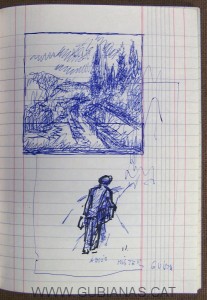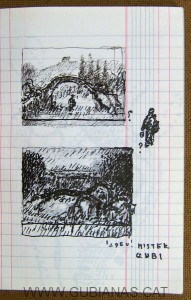![]()
THE ARTIST ↓…………… TEXTILE DRAUGHTSMAN → …………….SCHOOL “ PARC DEL GUINARDÓ ” →……………… NEWS →
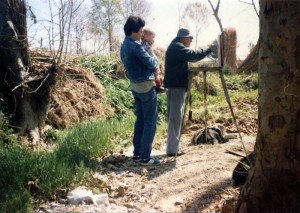 This website prays posthumous homage to Jaume Gubianas Jovés, a man who devoted all his life to the Art of Painting from life. Thanks to his perseverance and effort, he would spend time drawing at the same time that he would make his hobby become his profession.
This website prays posthumous homage to Jaume Gubianas Jovés, a man who devoted all his life to the Art of Painting from life. Thanks to his perseverance and effort, he would spend time drawing at the same time that he would make his hobby become his profession.
The age of 18 years, it began to participate in numerous acts and exhibitions, and from 1942 to 1950, given its artistic qualities it was able to be an credited sketcher.
The age of 18 years, it began to participate in numerous acts and exhibitions, and from 1942 to 1950, given its artistic qualities it was able to be an credited sketcher. …………………………………………………………………………………………………………………………………………………………………. 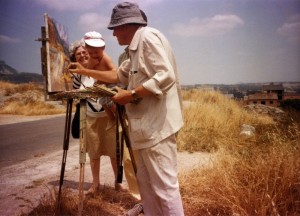 He wished to remain anonymous, concentrated on his activities both as a drawing teacher and as a textile painter and drawer. He did not want to waste his short spare time with the aim of gaining notoriety and taking a relevant place in the artistic world,since it was not a matter of importance for him.
He wished to remain anonymous, concentrated on his activities both as a drawing teacher and as a textile painter and drawer. He did not want to waste his short spare time with the aim of gaining notoriety and taking a relevant place in the artistic world,since it was not a matter of importance for him.
Giving preference to my principles, I am determined to open the window for you to lean out and have the chance of observing and enjoying his exquisite work. I try to achieve the place to which he would have corresponded those days, and which he undoubtedly deserves today.
Finally to be grateful for your attention and support.
Santiago Gubianas.
![]()
Biography
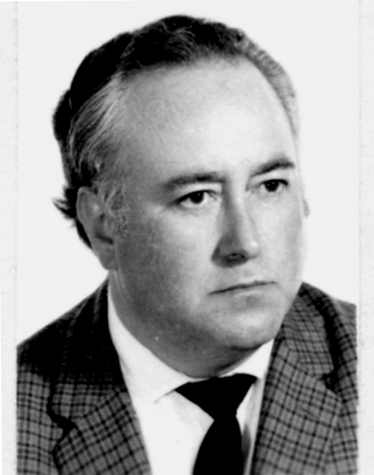
Jaume Gubianas Jovés (1923-2001) was born on the 25th December in 1923. When he was just a child, he felt strongly attracted to the art of drawing. At the beginning, he enhanced the creativity of his drawings. However, shortly after he started to develop a good sense of the representation and colour in his art, and it was from that moment onwards that one could perceive the sensitivity of the lines in his work.
Despite some trouble, he managed to study what he wanted. On his early years of training, he would attend both the School of Arts and Crafts of Barcelona and La Llotja. Subsequently, he entered the School of Fine Arts in the city of Barcelona, where lots of different people from the rest of Catalonia came together.
When he finished his studies, he already knew he wanted to teach, and in the course of his life he combined both his job as an art teacher and as professional painter. In parallel with this, he specialised his career in textile drawing, and he would carry out countless assignments for manifold important firms of textile design.
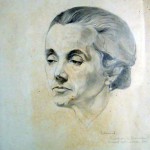
As an instance of his early work, it is worth mentioning that two of his drawings in pencil –“Mi Madre” and “Cabeza de Perro”- were on view in the National Exhibition of Fine Arts of Barcelona, in 1942, when he was only 18.
His work is so large that it spreads over many different towns and places. On the one hand, places where he lived for long periods of time. On the other hand, places where he just spent a few days, and some others where he spent enough time so as to create great art. Manresa, Brafim, Alentorn, Viladecans and Barcelona, among others, are some good examples.
Many of his paintings are part of several important private collections from different parts of the world, such as Catalonia, France, Switzerland, Germany, Australia and the USA.
Finally, he died on the 9th September in 2001 in Viladecans, the city where he had spent the latest spell of his life.
Hindsight
The painter’s work covers a wide range of codes. In the course of his life, he strenuously covers a route which is defined by the different stages and phases where he develops a personal and distinct view of those things that surround him. He gives impression to all his feelings, thoughts and obsessions for life, light and nature. His work goes through each and every evocative way of expression. From etching to dry point; fountain pen or paintbrush to ink; as from watercolour to tempera, or even oil painting, he captures almost every approach to reality in order to alternate different techniques and procedures. He is meticulous in the creative process, a great connoisseur of art materials and all kinds of substances, such as pigments and resin, which are always used as if it all was about alchemy, bringing him to surprisingly good results.
His painting is essentially Mediterranean; it contains the peculiarity that identifies many great painters, which is the influence of light coming into contact with surface. These great painters aforementioned were fortunate to meet in that specific geographical spot, which is characterised by the revealing vibrancy of its colours and light.
Taking into account that all his work is from life, it overcomes all kind of adverse weather conditions and reflects a concrete appeasement within a particular solar time, which characterizes and defines him as a peculiar painter among his contemporaries, who progressively were more inclined towards study painting with artificial light and photographic reference as a source of inspiration.
As for styles, he experimented with almost all of them with no concern about the different artistic movements and vanguards of those days, hegemonic and fleeting for him. What he wanted was simply to express life though painting. Perhaps, from a theoretical point of view, his most characteristic and relevant style is the one under the name of Realism.
Finally, perseverance is the quality that underlies beneath each and every one of his paintings. The methodology he uses –general and specific-, the sun, the light and the time are the manifold elements he employs to regard painting as philosophy of life, as a way of life.
As far as the themes are concerned, in the same way he did with a variety of techniques, he dealt with all the existing themes; however, there are four different stages that stand out:
– Animals (1942-1947)
– Streets (1968-1973)
– Seascapes (1965-1975)
– Landscapes (1975-2001)
Criticism and opinion
Detailed information in “ARCHIVE”
Chronology
Detailed information in “ARCHIVE”
References
- 1948. Biographical Encyclopaedia of the World. New York: Institute for Research in Biography.
- J.F.Ráfols. 1951. Diccionario Biogrí¡fico de Artistas de Catalunya. Barcelona: Ed. Millá.
- J.F. Ráfols. 1980. Diccionario de Artistas de Cataluña, Valencia y Baleares. Barcelona- Bilbao: Edicions Catalanes S.A. y la Gran Enciclopedia Vasca.
- 1994. Diccionario de Pintores y Escultores Españoles del siglo XX. Madrid: Ed. Forum Artis S.A.
- 2009. Enciclopèdia Catalana, SAU . Barcelona.
![]()
Most people, I myself to take an obvious example, probably would not be interested in the life and work of a particular artist if it was not by someone that offers us the chance. I want to cooperate in the publication of a person’s legacy, with whom I shared many experiences, through which I was taught essential values of life, and which helped me to enjoy life. He held me in his arms while the first beatings of my heart and we hold hands while his latest. Hence, my comments are sincere, though subjective.
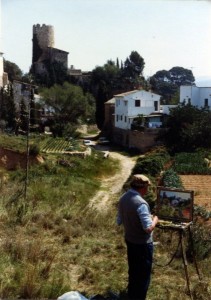 I remember him lively and educated, I loved listening to him. When he was in the prime of life, I keep the image of a tall man, with white beard and rosy cheeks.
I remember him lively and educated, I loved listening to him. When he was in the prime of life, I keep the image of a tall man, with white beard and rosy cheeks.
Looking like a bohemian, he always wore a cap and, while smoking a pipe, he carried a briefcase plenty of watercolours, a tripod and a collapsible chair. He remained motionless for hours, watching his objective until he managed to stop the time in order to reflect a fixed image from a changing dimension. This odd ability to depict in a picture something that varies as time goes by always astonished me.
The palette and the paintbrush were the instruments he used to capture in a canvas the combination of his senses when observing and enjoying nature. Painting is the door which opens our soul and, wide open, digs a path for us to reach the infinite feelings. I am pleased to share the passion I have for painting as well as the admiration I feel for the one who gives us the opportunity to know moments and places, inaccessible otherwise.
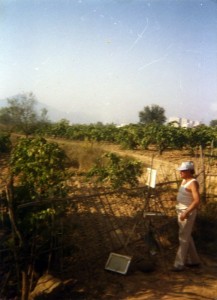 Each picture is not only a research on the detailed features of a face or of a landscape, but it is also a proposal of what the painter sees and what it transmits him. In any case, it is fascinating to contemplate how those faces and landscapes change, but above all, it is fascinating to contemplate the trace hidden behind each and every one of his pictures -which makes every artist different from each other-, which is his Personality.
Each picture is not only a research on the detailed features of a face or of a landscape, but it is also a proposal of what the painter sees and what it transmits him. In any case, it is fascinating to contemplate how those faces and landscapes change, but above all, it is fascinating to contemplate the trace hidden behind each and every one of his pictures -which makes every artist different from each other-, which is his Personality.
I would like to seize the opportunity to mention to his wife Susi, muse and source of inspiration sometimes and accomplice many others. She had always been his loyal comrade.
I tried to be on the same level of my mind and to express my ideas in this writing, which I believe is an ambitious purpose as well as a very gratifying challenge.
Manuel Aguilar.
It was a very cold and hazy winter morning, while the painte shrunken by the cold was sat down in a very small chair – near the river of Olesa de Bonesvalls-, a man was approaching him little by little and, when he was only a few metres from the painter, he exclaimed ‘Good morning!’. Just after, while returning to where he came from, he shouted ‘I told you so. It isn’t an olive, but a painter…you owe me a beer’!
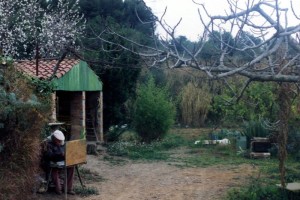 For sure, it was because of the painter’s olive colour jacket that those men confused him with a tree. However, what really made those men become confused was the time at which the painter was painting, very early in the morning.
For sure, it was because of the painter’s olive colour jacket that those men confused him with a tree. However, what really made those men become confused was the time at which the painter was painting, very early in the morning.
This anecdote is a reflection of Jaume Gubianas’ personality. He was a hardworking, persistent, disciplined and critical man. He always told me the words of the maestro Pau Casals: “If any day I do not play, I notice. If they are two, my wife does, and if more than three days, the audience realizes it”. I met the painter in 1990 and, until his dead in 2001, I would count on the fingers of a hand the days he did not paint. “Whether it is Sunday or Christmas Eve, the sun will rise anyway” he argued.
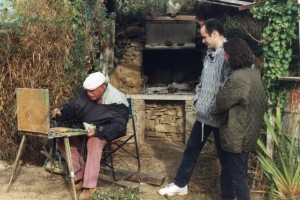 Even in the latest days of his life, he painted “notes” as he said. Within these ten years of friendship, he painted each and every one of the corners of the Verdera and the Oliveretes areas from Viladecans, where we used to coincide with each other. He painted in oils, in watercolours and in charcoal. When my grandfather pruned the grapevine, he burnt the vine shoots, of which he made charcoals in order to draw. Where one could simply see a common pea, he was able to go further and see a ‘masterpiece’ of Nature, which he would modestly reflect either in a canvas or in a sheet of paper.
Even in the latest days of his life, he painted “notes” as he said. Within these ten years of friendship, he painted each and every one of the corners of the Verdera and the Oliveretes areas from Viladecans, where we used to coincide with each other. He painted in oils, in watercolours and in charcoal. When my grandfather pruned the grapevine, he burnt the vine shoots, of which he made charcoals in order to draw. Where one could simply see a common pea, he was able to go further and see a ‘masterpiece’ of Nature, which he would modestly reflect either in a canvas or in a sheet of paper.
In this area of Viladecans, which in the near future will regrettably become concrete and blocks, we sat down under the hundred-year-old fig trees and, as if it was a Greek forum, we had very valuable and thoughtful conversations. He taught me lots of interesting things which one cannot learn in any other place, and which very few people can actually teach you. Apart from a painter, he was an authentic humanist. “ The one who only knows about medicine does not even know anything about medicine” he told me very often, quoting Dr. Letamendi’s words.
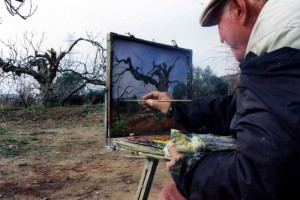 The latest painter’s pictures are depictions of the Oliveretes and the Verdera areas, which are an authentic treasure. Oils, above all, are of extreme quality to which I have to add a sentimental value. He was respectful with the sunlight, he never devoted more than two hours in a row to the same picture, since the light contributes to the final result. Unlike his contemporaries, who preferred to create abstract shapes and who became famous, not believing in their art -earning money, though-, he did not want painting become his profession. Apart from giving lessons, he decided to remain anonymous and keep his own clear and personal principles, which are patent in many of the pictures we can see today.
The latest painter’s pictures are depictions of the Oliveretes and the Verdera areas, which are an authentic treasure. Oils, above all, are of extreme quality to which I have to add a sentimental value. He was respectful with the sunlight, he never devoted more than two hours in a row to the same picture, since the light contributes to the final result. Unlike his contemporaries, who preferred to create abstract shapes and who became famous, not believing in their art -earning money, though-, he did not want painting become his profession. Apart from giving lessons, he decided to remain anonymous and keep his own clear and personal principles, which are patent in many of the pictures we can see today.
Jordi Mazon.
MEMOIRS
He was born the 25th December in 1923, in the bosom of the family coming from Manresa. He was the last but one of all his siblings.
Since he was just a child he already had the passion for painting. He wanted to reflect everything he saw on a peace of paper. However, due to his parents’ financial problems, they could not afford the expenses that this hobby implied. For this reason, any bit of a newspaper, for instance, would be usefull to draw. Experimenting with new materials would lead him to create his paintings on many different kinds of support, among others, sandpaper,. Animals was Jaime’s favourite topic at that time.
As time went by, his interest in this art was increasingly stronger untill the point of becoming a real obsession. He refused many jobs he had been offered, social relationships and everything that would prevent him from developing his artistic vocation.
Eventually, he found some jobs related to art as time passed by. In the mornings, he would be a draughstman in a textile company, and he would be a drawing teacher in the evenings. Every day, as soon as he got home after his long working day, he would prepare all the compounds to have everything ready to paint. He would paint every Saturday and Sunday morning and also on holiday time. Nevertheless, he would devote Sunday afternoons to spending the time with his family, however, he would always find a reason to make any note.
I will not tell the result of all these events mentioned above, since I am certain that you will be able to see it better in the following paintings. See the “ His Art ”
PHOTOGRAPH ALBUM
JAUME GUBIANAS JOVÉS PHOTOS. WHILE DRAWING. √ See >>>
JAUME GUBIANAS JOVÉS. SEEN BY OTHER ARTISTS. √ See >>>
![]()
The last Thursday 7th May 2009, the launchpad “Salvem Oliveretes” paid posthumous tribute to Jaume Gubianas Joves. They screened the latest masterly short created byDidac . It is a brilliant short that travels round the artist life through his work, an evidence for the beauty of a place that is so close to us, Les Oliveretes.
VIDEO IN HONOUR OF JAUME GUBIANAS JOVÉS IN WWW.SALVEMOLIVERETES.ORG
Donwnload video for personal use only HERE >>> ( 67.9 Mb català, próximament english ).
![]()
BYE BYE MR. GUBI
……………………………………………………………………………………………………………………………………………………………….
Since 1949 he did not name any of his paintings, but for this one which, according to some found sketches,
by way of farewell was entitled under the name of
“Bye-bye, Mr. Gubi”
“Mr. Gubi” was the way he was called by his students.
CLARIFICATION
In order to avoid confusion on the net, we refer to the painter in all sites as:
Jaume Gubianas Jovés
not to confuse with:
Jaume Gubianas Escudé
A world-famous artist and great illustrator nowadays
……………………………………………………………….![]()
![]()
 english
english español
español català
català
